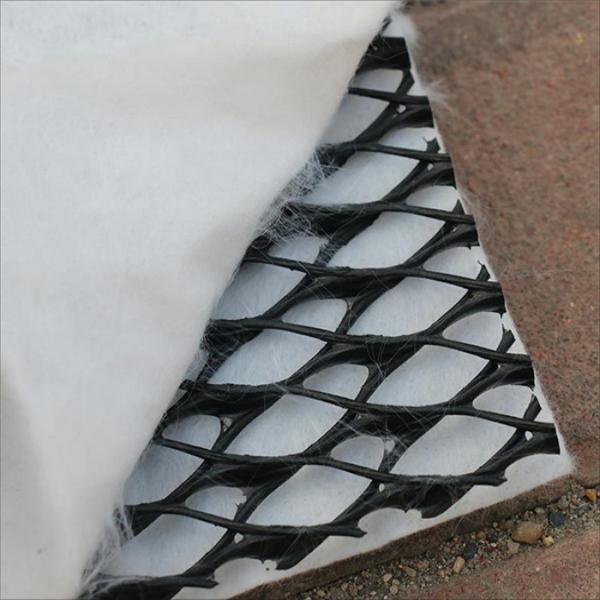Three-dimensional composite drainage network
Short Description:
- The three – dimensional composite drainage network is a multi – functional geosynthetic material. It cleverly combines a three – dimensional geonet core with needled non – woven geotextiles to form an efficient drainage structure. This structural design makes it perform excellently in many drainage and foundation treatment applications.
- The three – dimensional composite drainage network is a multi – functional geosynthetic material. It cleverly combines a three – dimensional geonet core with needled non – woven geotextiles to form an efficient drainage structure. This structural design makes it perform excellently in many drainage and foundation treatment applications.

- Structural Characteristics
- Three - Dimensional Geonet Core
- The three - dimensional geonet core is the central part. It has a unique three - dimensional structure, in which the vertical ribs and the obliquely - placed ribs are intertwined. The vertical ribs can provide excellent vertical drainage channels, enabling water to flow rapidly in the vertical direction. The obliquely - placed ribs increase the overall stability and lateral drainage capacity of the material, allowing water to be drained effectively in different directions.
- This structure is like a complex and orderly drainage network, which can effectively collect and guide the water flow. Moreover, the design of the three - dimensional geonet core enables the drainage network to maintain the unobstructed drainage channels even under a certain pressure.
- Needled Non - woven Geotextiles
- The double - sided needled non - woven geotextiles have several important functions. First of all, it can prevent soil particles and other impurities from entering the interior of the drainage network and acts as a filter. It's like a sieve that only allows water to pass through while blocking solid particles.
- Secondly, the geotextile can also protect the three - dimensional geonet core from damage by the external environment, such as ultraviolet radiation and physical wear, thus prolonging the service life of the three - dimensional composite drainage network.
- Working Principle
- When the three - dimensional composite drainage network is applied to a drainage system, it is placed in the area that needs drainage, such as the subgrade or the bottom of a landfill. The water enters the three - dimensional geonet core through the geotextile and then flows in the drainage channels of the core. Due to its three - dimensional structure that provides drainage paths in multiple directions, the water can be quickly guided to the specified drainage outlet.
- In terms of blocking capillary water, when the drainage network bears a high load, its internal pore structure can effectively prevent the rise of capillary water. Capillary water is a phenomenon of water rising due to the surface tension in the soil pores, which may have an adverse impact on the stability of roads, buildings and other structures. The three - dimensional composite drainage network can prevent the rise of this capillary water under high - load conditions through its special structural and material characteristics.
Performance Advantages
- High - Efficiency Drainage
- The three - dimensional composite drainage network has a fast drainage speed and can quickly drain accumulated water and reduce the residence time of water inside the structure. For example, in road construction, rapid drainage can effectively prevent damage to the road surface caused by accumulated water, such as cracks and potholes.
- Reinforcement and Isolation Effects
- As an isolation material, it can separate different - natured material layers. For example, in subgrade engineering, it can prevent the fine - grained soil at the bottom of the subgrade from entering the upper aggregate layer and maintain the independence and stability of each material layer.
- At the same time, it can also reinforce the foundation. By restricting the lateral movement of the foundation material, it increases the bearing capacity of the foundation, just like putting a "reinforcement armor" on the foundation, enabling the foundation to better bear the weight of structures such as buildings or roads.
- Corrosion Resistance and Durability
- The three - dimensional composite drainage network can resist the corrosion of a variety of chemical substances, including acid - base substances that may exist in soil and water. This corrosion resistance enables it to work stably for a long time under different geological and environmental conditions.
- Its durability is also excellent, and it can withstand the influence of external factors such as long - term pressure and water flow scouring, reducing the trouble and cost of frequent material replacement.
- Wide Range of Applications
- Road Engineering : In the construction of highway and railway subgrades, it is used to drain groundwater and enhance the stability of the subgrade. It can effectively prevent the subgrade from softening due to accumulated water and improve the service life of the road and driving safety.
- Landfill : Installed at the bottom and slopes of landfills, it is used for drainage and preventing leachate leakage. Its drainage function can promptly drain the liquid generated by garbage decomposition.









